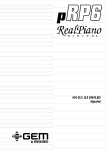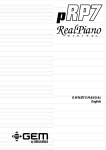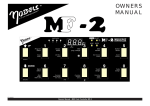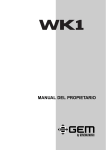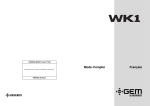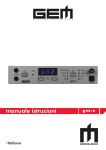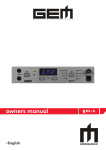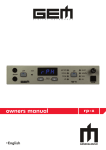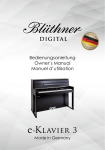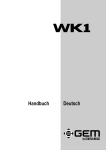Download Peavey pRP 6 Electronic Keyboard User Manual
Transcript
OWNER’S MANUAL English General safety instructions Power supply • This keyboard is powered by current from a standard household wall outlet (using the supplied AC adaptor). About the AC adaptor • Use only the supplied AC adaptor. Use of another type of adaptor creates the danger of fire and electric shock. For safety sake, be sure to unplug the AC adaptor from the wall outlet whenever leaving the keyboard unattended for a long time. • Always ensure that the instrument is turned OFF when connecting or disconnecting the power adaptor. Applying power while the power switch in depressed may damage the components inside the unit. • Do not use adapters other than the one specified for this keyboard. The technical specifications of the adapter must be: 9~12V DC output, 1800MA, centre positive type. If water gets into the instrument • Remove the power cord from the wall socket at once, and contact the store where the unit was purchased. • The top surface of your instrument should never be used as a shelf for flower vases and other containers which hold liquids. If the instrument plays in an abnormal way • Turn off the power immediately, remove the power cord from the main outlet and contact the store where it was purchased. • Discontinue using the unit at once. Failure to do so may result in additional damage or other unexpected damage or accident. General user maintenance • Clean the cabinet and keys of your instrument using a soft, clean, slightly damp cloth and polish with a soft, dry cloth. • Never use industrial cleaners, detergents, abrasive cleansers, waxes, solvents or polishes as they may damage the instrument finish. • Always turn off the power supply after use and never turn the unit on and off repeatedly in quick succession as this places an undue load on the electronic components. The information in this publication has been carefully prepared and checked. The manufacturers however decline all liability for eventual errors. All rights are reserved. This publication may not be copied, photocopied or reproduced in part or in whole without prior written consent from Generalmusic S.p.A. Generalmusic reserves the right to apply any aesthetic, design or function modifications it considers necessary to any of its products without prior notice. Generalmusic declines all liability for damage to property or persons resulting from improper use of the instrument. © 2000 Generalmusic S.p.A. All rights reserved. Contents Introduction 1 Instrument Overview 2 Control panel 2 Rear panel 3 Playing the pRP6 4 Connect the power supply 4 Turn the instrument on 4 Adjust the overall volume 4 Headphone jack 4 Pedal Connection 4 Listen to the Demo song 4 The pRP6 Presets 5 The functions of the pRP6 6 Touch sensitivity 7 Transpose 8 Tune 9 MIDI Channel 10 Midi Local 11 Midi Common channel 12 About MIDI 13 MIDI Applications 15 As a MIDI controlling device 15 As a Slave device 15 Midi Sequencer recording 15 Panel Reset 16 Technology 17 Damper Physical Model 17 Technical specifications pRP6 17 Index 18 Appendix GM-GMX Sound tables A.1 Preset table A.3 Drumkit tables A.4 Midi Implementation chart A.7 Recognized Control Change messages A.8 i ii Introduction Thank you for purchasing the new GEM pRP6, the new portable Digital Piano belonging to the prestigious Real Piano Series by Generalmusic. pRP6 features the same sound characteristics as the higher end sister models, but with a control panel situated on the left key block consisting of just 4 elements to reduce user interventions to the bare minimum. pRP6 combines advanced technology, reliable high quality componentry and an easy-to-use interface to produce the unique Real Piano sound. With its 32 note polyphony and 76 note, half-weighted keyboard, pRP6 is the modern, economical answer to portable piano playing. pRP6 offers 32 new Presets including 10 exclusive piano sounds. Also featured is an internal Sound Library consisting 444 GM/GMX compatible sounds, addressable via MIDI from any external MIDI controlling device. The Presets are further enhanced by the 22 Reverb and 22 Delay/Modulation digital effects which are automatically recalled for every Preset selection. The built-in stereo amplification system, giving 6W + 6W power faithfull reproduces the complex sound diffusion of an acoustic piano. pRP6 is very easy to use, but to make the most of the instrument’s features, you are recommended to consult this manual whenever you are not sure what to do. Most important, of course, is how you treat your pRP6. Please take time to read the General Safety Instructions to guarantee a long and trouble free use of your instrument. 1 Instrument Overview Control panel 1 2 5 1. POWER ON/OFF 2. VOLUME 3. DATA m/n 3 4. GRAND PIANO 4 2 5. FUNCTION KEYS Press to turn the instrument on and off. Control knob to regulate the general volume of the instrument. Use these buttons to select Presets (single, layer or split sound combinations). Press both buttons at the same time to trigger the DEMO song. In Function mode, the Data m/n buttons change the parameter status of the current function. The functions are selected with the last six notes of the highest octave of the keyboard. Press this button to select the GrandPiano Preset which instantly recalls the GrandPiano sound across the entire keyboard. Notes B6-G7 of the highest octave are dedicated to the selection of the pRP6 functions. The function parameters are selected with the Data m/n buttons while holding down a function key. Rear panel 1 1. MIDI IN/OUT: 2. PEDALS: 3. INPUT RIGHT/M-LEFT: 4. OUTPUT RIGHT/M-LEFT: 5. PHONES: 6. 12 V DC: 2 3 4 5 6 These ports allow the instrument to be connected to other MIDI devices. Midi In allows the sounds of the pRP6 to be played by an external controlling device e.g. a controller keyboard or a sequencer. Midi Out sends MIDI information from the pRP6 to other MIDI external equipment. Two pedal connectors (Damper and Soft) for optional switch-action pedals. These two stereo inputs are used to connect another instrument to the pRP6. The output of the other instrument will be mixed with the main signal of the pRP6 and sent to the Output and Headphone jacks. If you are connecting a mono signal, then you should use only the Right/Mono jack. These two stereo outputs are used to connect the instrument to another amplifier, mixer or recording device. If you are connecting to mono equipment, (e.g. a guitar amplifier), then you should use only the Right/Mono jack. Plug a set of stereo headphones into this jack for private listening. Connection for the power supply unit. Use only the unit supplied with your instrument. 3 Playing the pRP6 Connect the power supply Connect the Generalmusic power supply unit to the 12V. D.C. jack. Turn the instrument on To turn the pRP6 on, press the ON/OFF switch located on the left key block. After a short period, the instrument is ready to play the Grand Piano preset. The LED of the Grand Piano Preset button will be on as an indication that the instrument is on. In this power up condition, you will be able to play a piano sound (GrandPiano) across the entire keyboard without carrying out other operations. Adjust the overall volume Use the VOLUME control knob to adjust the overall volume level. Clockwise rotation of the VOLUME control knob increases the overall volume and counter-clockwise rotation decreases it. Headphone jack The headphone jack is located on the rear connections panel. Plugging a set of headphones into the Phones jack will exclude the internal speakers to allow you to play in total silence without disturbing others in the same room. Use a mini jack1/4” adapter for Walkman or MidiDisc headphone sets. Use the Volume control to adjust the Headphones volume. Pedal Connection The pRP6 has two connectors for the connection of optional, switch-action pedals: SOFT and DAMPER. Soft: The Soft pedal (left) is a switch control pedal (On/Off) which affects the timbre of the instrument such that it plays softer, allowing you to continue using the same playing style at a lower volume. Damper: The Damper pedal (right) applies the Sustain effect to all notes released. If you release a note after depressing the Damper, the note will proceed towards its natural decay according to the type of sound played. The Damper is particularly effective with Piano type sounds. Listen to the Demo song The pRP6 contains a demonstration recording of the internal sounds. Press both the DATA m and n buttons at the same time. 1. The Demo song will start to play instantly. When it reaches the end, it will start from the beginning and repeats continually until stopped. To stop the playback at any point, press both DATA m/n buttons at the same time. 2. You can also use the Grand Piano Preset button to stop the Demo. 4 LED on The pRP6 Presets The pRP6 contains 32 Internal Presets, consisting of Single, Layered and Split sound combinations. Each sound combination of the Presets recalls an appropriate configuration of effects (Reverb and Chorus) together with Volume and Balance settings. The table shown opposite lists the pRP6 Presets. After each name, the type of Preset is indicated in brackets: “S” for Single, “L” for Layer and “Sp” for Split. Using the SOUND/DATA m/n buttons, it is possible to select the pRP6 Presets sequentially. 1. N° 1. 2. 3. 4. 5. 6. 7. 8. 9. 10. 11. 12. 13. 14. 15. 16. Name Stage Piano (S) Rock Piano (S) Rhodex (S) Hard Rhodex (S) Wurtlitz (S) FM Piano (S) El. Glock Piano (L) Harpsi (S) Vibes 1 (S) Piano/Strings (L) Stage Piano/Strings (L) Stage Piano/Bass (Sp) Piano/Bass (Sp) Rhodex/Ride (Sp) FM Pad (L) FM/El.Bass (Sp) N° 17. 18. 19. 20. 21. 22. 23. 24. 25. 26. 27. 28. 29. 30. 31. 32. Name Harpsi/Strings (L) Vibes 2 (Sp) Rock Piano/Pad (L) Rhodex Pad (L) FM Piano Stage (L) Strings/Choir (L) Piano/Choir (L) Stage Piano/Poly (L) Rock Piano/Poly (L) Jazz Organ 1 (S) Pop Organ (S) Theatre Organ (S) Church Organ (L) Jazz Organ 2 (Sp) Organ/Bass (Sp) Church/Choir (L) After turning the pRP6 on, press the DATA m button. You will recall the first Preset, called Stage Piano which plays across the entire keyboard. 2. Press the DATA m button again to recall the Preset,” Rock Piano”. Every time you press the DATA m button, you will select the Presets in increasing numerical order. When you reach the last Preset on the list, Church/Choir, pressing the Data m button will have no effect. 3. Press the DATA n button. If you started with the Preset Rock Piano selected in step 2 above, you will return to the previous Preset “Stage Piano”. Every time you press the DATA n button, you will select the Presets in decreasing numerical order. Once you select the first preset, “Stage Piano”, pressing the Data n button will have no effect. 4. LED on To cancel the current Preset and return to the Grand Piano Preset, press the Grand Piano button. The Grand Piano button will always return to the Grand Piano Preset active across the entire keyboard. 5 The functions of the pRP6 pRP6 features 6 functions which affect the instrument in various ways. The Functions are activated using the last 6 notes of the highest keys of the keyboard. To activate a function and modify its value, hold down the corresponding key and press the DATA m/n buttons. The functions and corresponding notes are: TOUCH (B6) : changes the keyboard’s touch sensitivity (response to changes in the key-strike velocity); TRANSPOSE (C7) : changes the instrument’s overall pitch; TUNE (D7) : fine tunes the instrument; MIDI CH. (E7) : sets the instrument’s MIDI Channel (for MIDI setups); MIDI LOCAL (F7) : sets the instrument for MIDI Local operation (for MIDI setups). Local disconnects the pRP6 sound generation. MIDI COMMON (G7) : sets the instrument’s MIDI Common channel (for MIDI setups). The Common channel is useful to control another MIDI device which has automatic arrangements. 6 Touch sensitivity If the keyboard of your pRP6 is too “hard” or “soft”, you may want to modify the touch sensitivity. Your pRP6 has a touch sensitive keyboard; in other words, the keyboard behaves just as in a traditional piano: the harder you play, the louder the sound. You can choose from three different velocity curves. SOFT, NORMAL, HARD The default status of the instrument corresponds to the NORMAL setting. 1. Press and hold the TOUCH function key (B6) then press the DATA m button to select the SOFT curve, or the DATA n button to select the HARD curve. Pressing either button, the instrument automatically plays a reference note C with an intensity corresponding to the current velocity setting. In this case, the current setting is NORMAL (default) and the reference note C will play with a medium intensity. 2. If you press the DATA m button a second time, you will select the SOFT velocity curve, identified by the reference note C which will play with a greater intensity. The SOFT setting corresponds to the most sensitive keyboard response which permits maximum sound levels with a light touch. 3. If, instead of Data m in step 2, you press the DATA n button a second time, you will select the HARD velocity curve, identified by the reference note C which will play with less intensity. The HARD setting corresponds to a not so sensitive keyboard response which requires a heavier touch to obtain maximum sound levels. 4. Release the Touch function key, (B6), to retain the new setting. The current Touch setting will remain memorized even after turning the instrument off. To restore to the Normal setting, see step 5 below. From Hard to Soft If you press the DATA m button when the current setting is HARD, as in step 3, pressing the DATA m button once will play the reference note of the current setting, pressing a second time will select NORMAL, then pressing a third time will select SOFT. In this case, you will hear the reference note play with three different intensities (low, medium and high). From Soft to Hard Similarly, if you press the DATA n button when the current setting is SOFT, as in step 2, pressing the DATA n once will play the reference note of the current setting, pressing a second time will select NORMAL, then pressing a third time will select HARD. In this case, you will hear the reference note play with three different intensities (high, medium and low). 5. To restore the NORMAL setting, hold down the Touch key, (B6), then press both Data m/n buttons at the same time. The reference note will play with a medium intensity as confirmation of the reset. 7 Transpose The TRANSPOSE function allows you to quickly change the overall pitch of the instrument, raising or lowering it in steps of one semitone at a time (max. +/– 12 semitones). The transposition applied remains in memory until changed again, or until the instrument is turned off. Turning pRP6 on again restores the normal pitch (C = C). 1. Hold down the TRANSPOSE function key, (C7), then press either the DATA m button or the DATA n button. Pressing either button, the instrument automatically plays a reference note C in the current pitch (note C). To raise the pitch of the instrument If you press the DATA m button a second time, the pitch will be raised by one semitone. 2. The note played in this case will be C#. The pRP6 will now be transposed to the new pitch (C = C#). Pressing DATA m again will raise the pitch by another semitone (C=D) and so on. Continue in this way until you obtain the required pitch. To lower the pitch of the instrument Hold down the TRANSPOSE function key (C7) and press the DATA n button once. 3. The instrument will play a note in the current pitch set in step 2 (in this case D) which will correspond to the reference note. Press the DATA n button again and the pitch will be lowered by one semitone. The note played in this case will be Db (C = Db). Press DATA n once more to lower the pitch by another semitone (C = C) so on. Continue in this way until you obtain the required pitch. Repeat the operations, always with C7 pressed, until you obtain the required transposition either above or below standard pitch. To escape from the TRANSPOSE menu, simply release the corresponding function key C7. The instrument will remain set at the new pitch until you change the setting, or turn the instrument off. When you turn the instrument on again, the Transpose setting will set automatically to the normal pitch. To cancel the transposition (without turning off) Hold down the TRANSPOSE function key (C7) and press both the DATA m and n buttons at the same time. 4. The normal pitch of the instrument will be restored (C=C), confirmed by the reference note which will play the note C. 8 Tune The TUNE function allows you fine tune the instrument. The tuning can vary between 427.5 Hz and 452.5 Hz (corresponding to an excursion of approx. one semitone) in steps of +/– 0.5 Hz. The default status of the instrument corresponds the equal standard A = 440 Hz. 1. Press and hold the TUNE function key (D7) and press either the DATA m or the DATA n button to raise or lower the tuning accordingly. The first time you press the DATA m or DATA n button, the instrument will automatically play a sinusoidal reference sound (A = 440 Hz). To raise the tuning 2. While still holding down the TUNE function key (D7), press the DATA m button again to obtain the first increment (+0.5 Hz). Continue in this way until you obtain the required tuning level. The sinusoidal reference sound will help you fine tune the instrument. Release the TUNE function key (D7) to escape the function. To lower the tuning 3. While holding down the TUNE function key (D7), press the DATA n button to activate the function. You will hear the reference sinusoidal sound play with the last set tuning (the one set in step 2 above). Press DATA n again to obtain the first decrement (–0.5 Hz) and continue in this way until you obtain the required tuning level. Release the TUNE function key (D7) to escape the function. The current Tune setting will remain memorized even after turning the instrument off. To restore the pitch to normal, see step 4 below. To reset the tuning 4. Hold down the TUNE function key (D7) and press both the DATA m/n buttons at the same time. You will hear the reference sinusoidal sound play with the standard Pitch (C=C), or with the current Transpose pitch. 9 MIDI Channel pRP6 is able to transmit MIDI messages on up to three channels, depending on the type of Preset recalled (single, layer or split). In reception, pRP6 can receive on all 16 MIDI channels. The MIDI function allows you to modify the MIDI transmission channels of the pRP6, used by the pRP6 to communicate with other MIDI devices through a MIDI cable. The Midi Channel function does not play a reference note during the setting operation. Press and hold the MIDI Channel function key (E7) and press the DATA m button to increase the transmission channel by one unit. 1. Each time you press the DATA m button, the MIDI channel setting increases by one unit. Repeat the operations, making a mental note of how many times you press the DATA m button with E7 pressed, until you obtain the required channel number. Press and hold the MIDI Channel function key (E7) and press the DATA n button to decrease the channel setting by one unit. 2. Each time you press the DATA n button, the MIDI channel setting decreases by one unit. Resetting to the default MIDI channel configuration 3. If you are not sure on which transmission channels pRP6 is currently set, you can reset to the default channel settings (Ch 1, 3 and 2) by holding down the MIDI Ch. function key (E7) and pressing both DATA m/n buttons at the same time. 10 Midi Local If you are using your pRP6 via MIDI as a controlling device connected to an external sound generator (expander, keyboard, etc.), when you play, you will hear the expander’s sounds together with the pRP6 Sounds. If you prefer to listen to the expander’s sounds alone, you can choose to exclude the RP sounds by setting the MIDI Local function to OFF. Setting this function to OFF disconnects the keyboard from the internal generator and transmits keyboard data via the pRP6 MIDI OUT only. The Midi Local function does not play a reference note during the setting operation. 1. Press and hold the MIDI Local function key (F7) and press the DATA n button once. Play the same note, or a note anywhere along the keyboard. You will not hear any sound. This is because MIDI LOCAL OFF setting has disconnected the keyboard from the internal sound engine. This setting will allow you to play your external expander’s sounds via MIDI without hearing the pRP6 sounds. 2. To return to MIDI LOCAL ON, press and hold the MIDI Local function key, (F7) and press the DATA m button. Play the same note, or a note anywhere on the keyboard. This time the keyboard will play. Via MIDI, with MIDI LOCAL ON, you will be able to play the pRP6 sounds together with the external expander’s sounds. 11 Midi Common channel The Common channel is a special channel that allows you to control other MIDI devices that have automatic arrangements. The Midi Common function does not play a reference note during the setting operation. 1 Press and hold the MIDI Common function key (G7) and press the DATA m button to set the Common channel to ON. The Common channel is set to OFF by default, therefore, pressing the DATA m button will set the Common channel ON. When on, the Common Channel is set to the value of 16 (fixed). Press and hold the MIDI Channel function key (G7) and press the DATA n button to deactivate the Common channel. 2. The Common channel will now be off. Resetting to the default Common channel 3. If you are not sure of the current status of the Common channel setting (on or off), you can reset to the default setting (Off) by holding down the Common Ch. function key (G7) and pressing both DATA m/n buttons at the same time. 12 About MIDI MIDI, the abbreviation for “Musical Instrument Digital Interface”, is a world standard interface that allows MIDI compatible instruments and other equipment to communicate with each other, in order to exchange data and control one another. MIDI is now a very common feature and a great deal of literature is available explaining all the standards implemented by MIDI. You are recommended to consult other specialized literature if you wish to know more about the standards implemented and how to apply them. This section limits itself to give some examples regarding the simplest forms of MIDI applications for your pRP6. The MIDI ports The pRP6 is fitted with two MIDI ports: MIDI IN and MIDI OUT. The MIDI IN port receives MIDI data from an external MIDI device which can be used to control the pRP6. The MIDI OUT port transmits MIDI data generated by the pRP6 (for example, note or velocity data generated by playing the keyboard). MIDI channels The “MIDI channels” used in the MIDI communication system is similar to television broadcasting. Each channel can receive a different stream of data with respect to the others. Exactly as occurs in television broadcasts, in order to exchange data, the receiving and transmitting devices must be tuned correctly. In other words, the MIDI controlling device and the MIDI receiving device must both be set to the same MIDI channel, selected from 16 possible channels. Multiple channel instruments, called multi-timbral units, can receive and transmit across several different MIDI channels at the same time, but each part must correspond to the same MIDI channel between the two communicating units. pRP6 is able to transmit on up to three MIDI channels. In reception, pRP6 can be used as a multi-timbral unit, because it can receive MIDI on 16 channels. Midi Common If you set pRP6 to receive MIDI messages on the Common channel, all program change messages received by pRP6 are interpreted as Preset Change messages, allowing you to play the 16 Presets from the external keyboard which emulates the pRP6 internal keyboard. Simply set the external controlling device to transmit MIDI messages on the same channel as the pRP6 Common channel. The pRP6 MIDI Sounds and Banks Via MIDI, your pRP6 offers some interesting features which cannot be achieved using the instrument on its own. On its own, the maximum number of Presets you can select on pRP6 are those listed on page 4, a total of 16, some of which recall single sounds, some two layered sounds across the keyboard and others two or three sounds on a split keyboard. When you use pRP6 as a slave device, a MIDI controller keyboard can play the pRP6 internal Midi sounds which are organized in four banks, the first three housing 128 sounds organized in “family” groups, and the fourth containing 60 sounds. The bank 1 sounds correspond to the industry standard General MIDI sound library, while banks 2 and 3 contain sounds taken from Generalmusic’s own extensive sound library. Bank 4 contains an additional 60 Sounds, but not organized i “family” Groups like those in banks 1, 2 & 3. Banks 2 and 3 also contain a Percussive family where you’ll find a selection of 16 Drumkits. 13 Another drumkit is also in Bank 4. These sounds and sound banks can only be selected via MIDI, not from the pRP6 control panel. To select these sounds via MIDI, you would have to send a Midi message to the pRP6 consisting of two parts: ControlChange/Bank Select (CC00-BankSelect) followed by a Program Change (PC). Refer to the Midi sound tables in the Appendix for information regarding the Banks and Program Change numbers of all the sounds and Drumkits. MIDI messages transmitted and received by pRP6 pRP6 transmits and receives the following type of MIDI information. Note and Velocity data: This is information pertaining to the note played and relative velocity value. The receiving device recognizes the note because it is defined by the “MIDI note number”, and the velocity value is defined by the “MIDI velocity value”. Whenever a key on the pRP6 is pressed, the note and velocity information is transmitted from the instrument’s MIDI OUT port to the receiving device. Conversely, pRP6 will play the corresponding notes whenever note and velocity data is received at the instrument’s MIDI IN port. Program Change numbers: This type of information relates to data which identifies the pRP6 Preset. pRP6 transmits MIDI Program Change numbers from 1 - 32, corresponding to the 32 Presets that can be selected from the panel. Whenever you select a Preset, the corresponding MIDI Program Change number is transmitted to the receiving device, causing the correspondingly numbered voices to be selected in the external MIDI unit, set to receive on the same MIDI channel as the pRP6. Conversely, whenever pRP6 receives Program Change number data (for 132) from an external MIDI device, the correspondingly numbered pRP6 Preset will be automatically selected, but only if received on the Common channel, otherwise, the internal Midi Sounds will be selected. Control Change messages: The Soft and Damper pedals of pRP6 generate Control Change data which is transmitted from the instrument’s MIDI Out port whenever the pedals are operated. The internal tone generator of the receiving device will respond to the pedal solicitations in the same way as the pRP6 Sound engine. Whenever the same type of Control Change data is received by pRP6, it will respond appropriately. 14 MIDI Applications The following explains how your pRP6 can be used in the most common MIDI setups suited to this instrument: a) as a MIDI controlling device (Master); b) as a tone generator (in other words, a Slave); c) for MIDI sequence recording. As a MIDI controlling device pRP6, like most MIDI instruments, transmits note and velocity information (touch response) via the MIDI OUT port whenever notes are played on the keyboard. If the MIDI OUT port is connected to the MIDI IN port of another MIDI keyboard (synthesizer, etc.) or a tone generator (more commonly called an “expander”, but essentially any device with an internal sound engine), the external unit will respond precisely to the notes played on the transmitting keyboard. The result is that such a setup allows you to play two instruments at the same time, using pRP6 as the controlling device (Master) and the other as the device being controlled (Slave). Quite simply, every time you select a Preset, you will send Program change messages to the external device who will respond by playing a second sound. As a Slave device As well as transmitting MIDI information, pRP6 recognizes the same type of data if received at the MIDI IN port from an external controlling device. In this case, the MIDI IN port of the pRP6 is connected to the MIDI OUT port of the external controlling unit. This, therefore, allows pRP6 to be controlled in exactly the same manner as described above, only this time, the pRP6 behaves as the slave and the external device the controller. Midi Sequencer recording The type of data transfer described above can be exploited very efficiently for MIDI sequence recording. For this connection, shown in the diagram, the pRP6 MIDI OUT is connected to the Sequencer MIDI IN, and the Sequencer MIDI OUT is connected to the pRP6 MIDI IN. This connection is more commonly know as a “MIDI Loop”. Any instrument with a sequencer, or a Computer running sequencer software, can be used to capture (record) the MIDI data transmitted by the pRP6. When the recorded data is played back, the pRP6 reproduces the recorded sequence in exactly the same manner as it was recorded. 15 Panel Reset pRP6 offers a Panel Reset function which allows you to restore the factory settings without turning the instrument off. For example, if you have changed some parameters, such as the MIDI channels, the tuning, the velocity curves, etc., you can restore the factory (default) settings with the following procedure: • Hold down the GRAND PIANO PRESET button and press both the SOUND/ DATA m/n buttons at the same time. 16 Technical specifications pRP6 Keyboard 76 keys, half-weighted Polyphony 32 notes maximum Presets 444 Sounds (MIDI addressable) 32 Presets - Single, Layer and Split, Grand Piano Preset, 22 Reverbs and 22 Effects (Delay/Modulations) memorized to the Presets Controls Volume, Data m/n, Touch, Transpose, Tune, Midi (Channel, Local, Common), Grand Piano Preset Demo 1 Demo Song Pedals Soft, Damper Connections Stereo In, Stereo Out, Phones, Pedals, Midi In, Midi Out, 12 V. DC. Amplification 6W + 6W Stereo Technology The pRP6 features a unique application of sound design technology patented by Generalmusic as “Damper Physical Model”. Damper Physical Model The damper pedal accurately simulates the effect of the dampers being moved closer to or further away from the strings of the piano. Because of this, effects such as partial or half damping can be achieved. The dampers can even be slowly “squeezed” back against the strings. When the damper pedal is depressed, the damper physical model will simulate the effect of sympathetic resonances being produced by the un-damped strings. Even if you are using a standard switch type pedal, you can hear the effect of the Damper Physical Model by comparing the sounds of notes played in the highest octave of the instrument with and without the damper pedal depressed. Note: The Damper Physical Model is applied to the Grand Piano sound only. 17 Index A About MIDI 13 C Common channel 12 Control Change numbers 14 Control panel 2 Controlling device 15 D Damper 4 Damper Physical Model 17 Demo song 4 Drumkits 13 F Fine tune the instrument 9 Functions of the pRP6 6 H Hard curve 7 Headphone jack 4 Headphones 4 I Introduction 1 L Presets 5 Program Change numbers 14 pRP6 as a MIDI controlling device 15 pRP6 as a Slave device 15 R Raise the pitch 8 Raise the tuning 9 Rear panel layout (connections) 3 Resetting the tuning 9 Restore the factory settings 16 S Sequencer recording 15 Slave device 15 Soft 4 Soft curve 7 T Technical specifications 17 Technology 17 Touch 6 Touch sensitivity 6, 7 Transmission channels 10 Transpose 6, 8 Transposition cancel 8 Tune 6, 9 Turn the instrument on 4 V Local On 11 Lower the pitch 8 Lower the tuning 9 M MIDI Applications 15 MIDI Channel 6, 10 MIDI Channels 13 MIDI Common 6, 13 MIDI Common channel 12 MIDI Local 6, 11 MIDI ports 13 MIDI Sequencer recording 15 MIDI Sound Banks 13 N Normal curve 7 Note data 14 O Overall volume 4 P Panel Reset 16 Pedal Connection 4 Pitch 8 Playing the pRP6 4 Power supply (12 V D.C.) 4 18 Velocity data 14 Appendix ○ A ○ ○ ○ ○ ○ ○ ○ ○ ○ ○ ○ ○ ○ ○ ○ ○ ○ ○ ○ ○ ○ ○ ○ ○ ○ ○ ○ ○ ○ ○ pRP6 MIDI Sound table (GM - GMX) Midi Bk 1 (Rom) PIANO group 00 Piano1 01 Piano2 02 Piano3 03 HonkyTonk2 04 E.Piano1* 05 E.Piano2* 06 Harpsichor 07 Clavinet CHROMATIC group 08 Celesta2 09 Glockenspl 10 MusicBox 11 Vibraphone 12 Marimba 13 Xylophone 14 TubularBel 15 Santur ORGAN group 16 Organ1 2 17 Organ2 18 Organ3 19 ChurchOrg12 20 ReedOrgan 21 Musette2 22 Harmonica 23 Bandoneon GUITAR group 24 NylonGtr 25 SteelGtr 26 JazzGtr1 27 CleanGtr 28 MutedGtr 29 Overdrive 30 DistGtr 31 HarmonxGtr BASS group 32 AcoustcBs1 33 FingeredBs 34 PickBass 35 Fretless 36 SlapBass1 37 SlapBass2 38 SynBass1 39 SynBass2 STRINGS group 40 Violin 41 Viola 42 Cello 43 Contrabass 44 TremoloStr 45 Pizzicato 46 Harp 47 Timpani ENSEMBLE group 48 Strings 49 SlwStrings 50 SynStrg1 51 SynStrg2 52 Choir 53 VoxOoh 54 SynVox 55 OrchHits2 Bk 2 (Rom) Bk 3 (Rom) PianoMk1 PianoW2 E.G.Piano12 DetPiano2 ThinRhodx2 E.Piano32 Harpsich22 SynClav PickPiano2 Pianoctave2 E.G.Piano22 Western2 E.Piano4 E.Piano5 Harpsich3 WowClav CelestaPlk2 GlockVibes2 WineGls12 Vibes2 Marimba22 Xylophone2 SoftBell2 BarChimes ToyPiano2 GlockChoir2 MusicBell SynVibes Mallet XyloTribal2 Oohlalaa Climbing2 16’1’Draw2 16’8’5’Drw SwOrgan* Church22 PipeOrgan2 Accord1 Blusette Cassotto Organ1WX2 JazzOrgan32 SynOrg12 Organ3WX2 Organ42 Accord22 WestHarmon OrganLfo2 SoloGtr 12StrGtr2 OctJzGtr2 ElGuitar1 Muted2 WhaGtr1 FuzzGtr SlowHarmx2 VocalGtr2 SteelGtr1 Hawaiian ChorusGtr2 Dyn.Muted* 5thOverdr2 HeavyGt2 HarmGtr32 AcoustcBs2 Dyn.Fingrd* Dyn.Bass2* AcidBass1 Dyn.Bass3* WXBass2 SynBass3 SynBass4 AcousticBs3 Dyn.Bass1* PckBass22 Flanged SlapSynBs2 StopBass TecknoBass2 RaveBass2 SlowViolin BowedViola SlowCello BowedBass OctTremolo2 OctPizz2 HarpDelay2 TimpaniEFX2 ViolinOrch2 ViolaPad2 CelloEns2 Staccato Plectra EchoPizz Spacehar2 Dyn.Orch I’I* StereoStrg2 StrgOrch2 SynStrg32 SynStrg42 VoiceUuh2 VoiceAah2 SkatVoices* Rave2 StrgGlock2 St.SlwStrg SynStrg52 Strings3 SlowUuh SlowAah2 Vocoder2 Dyn.St.Hit Midi Bk 1 (Rom) Bk 2 (Rom) BRASS group 56 Trumpet FlugelAttk 57 Trombone Trombone3 58 Tuba ShortTuba 59 MutedTrp1 MutedTrp2 60 FrenchHorn Dyn.FrHorn* 61 Brass Brass22 62 SynBrass12 SynBras22 2 63 SynBrass2 SlowHorn2 REED group 64 Soprano Soprano2 65 SoftSax SaxNoise2 66 TenorSax OctaveSax2 67 BaritonSax BaritDet2 68 Oboe OboeChiff2 69 EnglisHorn2 EngHorn22 70 Bassoon Bassoon2 71 Clarinet ClarSolo PIPE group 72 Piccolo HardFlute12 73 Flute Dyn.Flute1* 74 Recorder2 HardFlute22 75 PanFlute PanFlute2 76 BottleBlow BottleNois 77 Shakuhachi2 Shakupad2 78 Whistle Whistle1WX 79 Ocarina OcarinaPan2 SYN LEAD group 80 SquareWave2 Pulse12 81 SawWave ObxFilter2 2 82 SynCalliop Azimut2 2 83 ChiffLead Chopper2 84 Charang Jump2 85 SoloVox FiltRes12 86 5thSawWave2Decay12 87 BassLead Obx22 SYN PAD group 88 Fantasia2 NewAge2 89 WarmPad Obx12 90 Polysynth2 Fantasy22 91 SpaceVoice VocBells2 2 92 BowedGlass Prophet12 93 MetalPad2 Bright22 94 HaloPad2 Slave2 95 SweepPad Machiner2 SYN SFX group 96 IceRain2 Noiseres 97 Soundtrack2 MoonWind2 98 Crystal Wind2 2 99 Atmosphere Arp26000 100 Brightness WithGas2 101 Goblin Resonance2 102 EchoDrops Synthex12 103 StarTheme2 StarTheme22 ETHNIC group 104 Sitar SitarDet2 105 Banjo BanjoOct2 106 Shamisen ShamSitar2 107 Koto Kanoun2 108 Kalimba ShrtKalimb 109 Bagpipe BagpipeEns2 110 Fiddle Hukin 111 Shanai BacktoWS2 ○ ○ ○ ○ ○ ○ ○ ○ ○ ○ ○ ○ ○ Bk 3 (Rom) FlugelHorn WowTromb2 WowTuba Dyn.MtTrp* TotoHorns2 BrassRips SyntHorn2 AttkHorn2 SoprFilter SoftFilt TenFilter BariFilter OboeFilter HornFilter BassoonFlt ClarFilter HardFlt22 DynHiFlute2 Bubbler Dyn.Pan Tube ShakuVoice2 Whistle3WX2 OcarinaSyn2 Pulse22 Lyle2 SynLead12 Digital2 SoundTrk2 FiltRes22 Decay22 Obx32 PPG2 AnlgPad2 Fantasy32 Angels2 Prophet22 Analogic2 Atmosphere2 Decay32 BigRoom Slope2 SynLead22 GlockAthm2 PopUp2 NoGravity2 Synthex22 PowerBad2 SynSitar2 EthnicGtr2 SynSham TrpClarin SaxTrumpt BrassEns2 FiddleBell2 VoiceSpect ○ ○ ○ ○ ○ ○ ○ ○ ○ ○ ○ ○ ○ ○ ○ ○ ○ ○ Appendix A•1 Midi Bk 1 (Rom) PERCUSSIVE group 112 TinkleBell2 113 Agogo 114 SteelDrums2 115 Woodblock 116 Taiko 117 Melo.Tom1 118 SynthDrum 119 ReverseCym SFX group 120 GtFretNois 121 BreathNois 122 Seashore2 123 Bird 124 Telephone1 125 Helicopter2 126 Applause 127 GunShot Bk 2 (Rom) Bk 3 (Rom) Dk_Stand.1D Dk_RoomD Dk_PowerD Dk_Elect.D Dk_HouseD Dk_Jazz1D Dk_BrushD Dk_OrchD Dk_Stand.2D Dk_WSD Dk_Std.1WXD Dk_DanceD Dk_TechnoD Dk_Jazz2D Dk_M1D Dk_SY77D Gtr.WhaWha Zapp TickTack Scratch1 Telephone2 SynPerc32 HeartBeat Explosion2 GtrNoise KeyClick Drop Water Door Clackson2 PickScrape Bomb Sounds without a suffix Sounds with suffix 2 Sounds with suffix * Sounds with suffix D ○ ○ ○ ○ ○ ○ ○ ○ ○ A•2 Appendix = = = = ○ ○ ○ ROM Bk 4 (MIDI) 00 DetuneEP1 2 01 DetuneEP2 2 02 CpHarpsy 2 03 ChurcBel 2 04 DetnOrg1 2 05 DetnOrg2 2 06 ChurOrg2 2 07 ItAccord 08 Ukulele 09 12StGuit 2 10 Mandolin 11 HawGuitr 12 ChoGuitr 2 13 FnkGuitr 14 FbkGuitr 15 GuitarFb 16 S.Bass3 17 S.Bass4 2 18 Orchestr 2 19 S.Strng3 2 20 BrassTr2 2 21 S.Brass3 2 22 S.Brass4 2 23 TaisKoto 2 24 Castanet 25 ConcerBd 26 MeloTom2 27 808_Tom 28 GtCutNse 29 StrnSlap 30 Rain 2 31 Thunder 32 Wind 33 Stream 34 Bubble 2 35 Dog 36 Horse 37 Telephon 38 DoorCrak 39 Door 40 Scratch 41 WdChimes 42 CarEngin 43 Car Stop 2 44 Car Pass 2 45 CarCrash 46 Siren 47 Train 48 Jetplane 2 49 Starship 2 50 BurstNse 2 51 Laughing 2 52 Screamin 2 53 Punch 54 Heart Bt 55 FootStep 56 MachiGun 57 LaserGun 2 58 Explosin 2 112 DrumSFX Single Layer Switch Drumkit ○ ○ ○ ○ ○ ○ ○ ○ ○ ○ ○ ○ ○ ○ ○ ○ ○ ○ ○ pRP6 Preset tables Preset Number 1. 2. 3. 4. 5. 6. 7. 8. 9. 10. 11. 12. 13. 14. 15. 16. Name Stage Piano (S) Rock Piano (S) Rhodex (S) Hard Rhodex (S) Wurtlitz (S) FM Piano (S) El. Glock Piano (L) Harpsi (S) Vibes 1 (S) Piano/Strings (L) Stage Piano/Strings (L) Stage Piano/Bass (Sp) Piano/Bass (Sp) Rhodex/Ride (Sp) FM Pad (L) FM/El.Bass (Sp) Preset Number 17. 18. 19. 20. 21. 22. 23. 24. 25. 26. 27. 28. 29. 30. 31. 32. ○ ○ ○ ○ ○ ○ Name Harpsi/Strings (L) Vibes 2 (Sp) Rock Piano/Pad (L) Rhodex Pad (L) FM Piano Stage (L) Strings/Choir (L) Piano/Choir (L) Stage Piano/Poly (L) Rock Piano/Poly (L) Jazz Organ 1 (S) Pop Organ (S) Theatre Organ (S) Church Organ (L) Jazz Organ 2 (Sp) Organ/Bass (Sp) Church/Choir (L) ○ ○ ○ ○ ○ ○ ○ ○ ○ ○ ○ ○ ○ ○ ○ ○ ○ ○ ○ ○ ○ ○ ○ ○ ○ Appendix A•3 DRUMKIT TABLES DK_STAND1 113-2 ROLLSNARE FINGERSNAP ZAPP GunShot SCRATCH2 SCRATCH1 STICK SQCLICK HOUSERIM MUTBELL BDSTD2 BDSTD1 RIMSHOT1 SDSTD1 HOUSECLAP SDSTD4 TOMLOW HHCLO1S TOMLOW HHPEDAL TOMLOW HHOPEN2 TOMLOW TOMHIGH CRASH TOMHIGH RIDECYM CHINA RIDECUP TAMBSLP SPLASH COWBELL CRASH VIBRASLAP RIDECYM CONGASLAP BONGOLOW CONGAHSLAP CONGAHIGH CONGALOW TIMBALES TIMBLOW AGOGO AGOGO CABASA MARACAS WHISTLE WHISTLE GUIROSHORT GUIROLONG CLAVES WOODBLOCK WOODBLOCK QUICAHIGH QUICALOW TRIANSHORT TRIANLONG SHAKER JINGLEBELL WINDCHIMES CASTANETS MTSURDO OPSURDO 25 26 27 28 29 30 31 32 33 34 35 C2 36 37 38 39 40 41 42 43 44 45 46 47 C3 48 49 50 51 52 53 54 55 56 57 58 59 C4 60 61 62 63 64 65 66 67 68 69 70 71 C5 72 73 74 75 76 77 78 79 80 81 82 83 C6 84 85 86 87 88 DK_ROOM 114-2 < < < < < < < < < < BDROOM1 BDROOM1 < SDROOM1 < SDROOM2 TOMROOM HHTGHT1 TOMROOM < TOMROOM < TOMROOM TOMROOM < TOMROOM < < < < < < < < < < < < < < < < < < < < < < < < < < < < < < < < < < < < < DK_POWER 115-2 < < < < < < < < < < BDELECT1 BDROOM1 < SDROOM2 < SDSTD3 < HHTGHT1 < < < < < < < < < < < < < < < < < < < < < < < < < < < < < < < < < < < < < < < < < < < < < DK_ELECT. 116-2 < < < < < < < < < < BDELECT1 BDELECT1 < SDELECT < SDROOM1 TOMELEC < TOMELEC < TOMELEC HHOPEN1 TOMELEC TOMELEC < TOMELEC < ReverseCym < < < < < < < < < < < < < < < < < < < < < < < < < < < < < < < < < < < 89 90 91 92 93 94 95 C7 96 97 98 99 100 101 102 103 104 105 106 107 C8 108 “<“ = as DK_STAND1 113-2 ○ ○ ○ ○ ○ ○ ○ ○ ○ A•4 Appendix ○ ○ ○ ○ ○ ○ ○ ○ ○ ○ ○ ○ ○ ○ ○ ○ ○ ○ ○ ○ ○ ○ DK_HOUSE 117-2 < < < < < < < < < < BDHOUSE2 BDHOUSE HOUSERIM < < HOUSESD2 HOUSETCON HOUSEHH HOUSETCON HOUSEHH HOUSETCON HOUSERIDE HOUSETCON HOUSETCON HOUSERIDE HOUSETCON < < < < < HOUSECOWB < < < < < HOUSETCON HOUSETCON HOUSETCON < < < < < VOXHHCL < < < < < < < < < < < < < < < < < DK_JAZZ 118-2 < < < < < < < < < < < BDJAZZ < SDJAZZ3 < SDSTD3 TOMJAZZ HHTGHT1 TOMJAZZ < TOMJAZZ HHOPEN1 TOMJAZZ TOMJAZZ < TOMJAZZ < < < < < < < < < < < < < < < < < < < < < < < < < < < < < < < < < < < < < DK_SFX 112-4 (Bk6 via MIDI) HIGH Q SLAP SCRATCH PUSH SCRATCH PULL STICKS SQUARE CLICK METRO CLICK METRO BELL GUIT FRET N GUIT CUT N UP GUIT CUT N DW STRING SLAP FL.KEY CLICK LAUGHING SCREAMIN PUNCH HEART BT FOOTSTEP1 FOOTSTEP2 APPLAUSE DOOR CRAK DOOR SCRATCH WIND CHIMES CAR-ENGINE CAR-STOP CAR-PASS CAR-CRASH SIREN TRAIN JETPLANE HELICOPTER STARSHIP GUN SHOT MACHINE GUN LASER GUN EXPLOSION DOG HORSE BIRDS RAIN THUNDER WIND SEASHORE STREAM BUBBLE Drumkit tables 25 26 27 28 29 30 31 32 33 34 35 C2 36 37 38 39 40 41 42 43 44 45 46 47 C3 48 49 50 51 52 53 54 55 56 57 58 59 C4 60 61 62 63 64 65 66 67 68 69 70 71 C5 72 73 74 75 76 77 78 79 80 81 82 83 C6 84 85 86 87 88 DK_BRUSH 119-2 < < < < < < < < < < < BDJAZZ < BRUSHTAP BRUSHSLP BRUSREV TOMBRUSH HHTGHT1 TOMBRUSH < TOMBRUSH < TOMBRUSH TOMBRUSH < TOMBRUSH < < < < < < < < < < < < < < < < < < < < < < < < < < < < < < < < < < < < < 89 90 91 92 93 94 95 C7 96 97 98 99 100 101 102 103 104 105 106 107 C8 108 DK_ORCH. 120-2 < < HHTGHT1 HHPEDAL HHOPEN2 RIDECYM < < < < BDSTD3 BDORCH < SDORCH CASTANETS SDORCH TIMPANI TIMPANI TIMPANI TIMPANI TIMPANI TIMPANI TIMPANI TIMPANI TIMPANI TIMPANI TIMPANI TIMPANI TIMPANI < < < < < CRASHORCH < < < < < < < < < < < < < < < < < < < < < < < < < < < < Applause DK_STAND.2 113-3 < < < < < < < < < < BDSTD3 < < SDSTD4 < SDSTD3 < HHCLO2 < < < < < < < < < < < < < < < < < < < < < < < < < < < < < < < < < < < < < < < < < < < < < DK_WS 114-3 DK_STD.1WX 115-3 DK_DANCE 116-3 < < < < < < < < < < < < < < < < < < < < BDELECT1 BDELECT1 BDROOM1 BDELECT1 < < SDROOM2 SDELECT < < SDSTD3 SDROOM1 < TOMELEC HHTGHT1 < < TOMELEC < < < TOMELEC < HHOPEN1 < TOMELEC < TOMELEC < < < TOMELEC < < < ReverseCym < < < < < < < < < < < < < < < < < < < < < < < < < < < < < < < < < < < < < < < < < < < < < < < < < < < < < < < < < < < < < < < < < < < < < < BDPOWER SDELECT SDROOM2 SDSTD3 TOMHIGH TOMHIGH CABASA < TAMBSLP < COWBELL RIMSHOT2 BDJAZZ BRUSRIG DYNSDJAZZ BRUSHTAP TOMJAZZ TOMJAZZ HHCLO1S TOMJAZZ HHPEDAL WOODBLOCK HHOPEN2 HOUSCLAP BDSTD1 RIDECYM SDSTD1 RIDECUP TOMROOM TOMROOM SPLASH TOMROOM CRASH VIBRASLAP CHINA FINGERSNAP BONGOLOW BONGOLOW CONGASLAP CONGAHIGH CONGALOW GUIROLONG QUICALOW TIMBALES TIMBALES AGOGO TRIANLONG WHISTLE BDHOUSE1 NOISEPERC HOUSSD1 VOICES1 VOICES 3 VOICES2 VOXHHCL VOICES2 VOXHHCL VOXTIP VOXTAP CLAKSON DOLLYVOX TAMBSLP ROLLSNARE SDORCH HHCLO1S CLAVES CONGALOW QUICAHIGH AGOGO STICK STICK STICK STICK “<“ = as DK_STAND1 113-2 ○ ○ ○ ○ ○ ○ ○ ○ ○ ○ ○ ○ ○ ○ ○ ○ ○ ○ ○ ○ ○ ○ ○ ○ ○ ○ ○ ○ ○ ○ ○ Appendix A•5 Drumkit tables DK_TECHNO 117-3 < 25 26 27 28 < < < < < < < < BDTEKNO BDJAZZ HOUSERIM HOUSSD1 < HOUSESD2 HOUSETCON HHCLO2 HOUSETCON HHTGHT1 HOUSETCON HOUSERIDE HOUSETCON HOUSETCON HHOPEN2 HOUSETCON ReverseCym < < < < HOUSECOWB < < < < < HOUSETCON HOUSETCON HOUSETCON DYNSDJAZZ SDJAZZ2 < < < VOXHHCL < < < < < < < < < < < < < < < < < 29 30 31 32 33 34 35 C2 36 37 38 39 40 41 42 43 44 45 46 47 C3 48 49 50 51 52 53 54 55 56 57 58 59 C4 60 61 62 63 64 65 66 67 68 69 70 71 C5 72 73 74 75 76 77 78 79 80 81 82 83 C6 84 85 86 87 88 DK_JAZZ2 118-3 < < < < < < < < < < < BDJAZZ RIMSHOT2 SDJAZZ3 < DYNSDJAZZ TOMJAZZ HHTGHT1 TOMJAZZ < TOMJAZZ HHOPEN1 TOMJAZZ TOMJAZZ < TOMJAZZ < < < < < < < < < < < < < < < < < < < < < < < < < < < < < < < < < < < < < DK_M1 119-3 DK_SY77. 120-3 < BDROOM1 BDELECT1 BDHOUSE1 BDPOWER SDSTD1 SDORCH SDSTD3 HOUSSD1 SDROOM2 RIMSHOT1 SDROOM2 TOMLOW TOMROOM TOMLOW TOMROOM TOMHIGH HHCLO1S HOUSEHH HHPEDAL HOUSERIDE HHOPEN2 TAMBOURINE HOUSEHH CRASH CHINA RIDECYM RIDECUP CABASA VOXHHCL HOUSCLAP BONGOLOW BONGOLOW DARBKLOW DARBKHIGH CONGALOW CONGAHIGH TIMBALES TRIANSHORT TIMBALES TRIANLONG NOISEPERC NOISEPERC DOOR NOISEPERC SDSTD2 ROLLSNARE SDSTD3 BDSTD2 BDROOM1 BDELECT1 BDPOWER TOMLOW TOMLOW TOMHIGH TOMHIGH BDHOUSE1 BDSTD2 SDSTD1 TOMROOM TOMROOM SDSTD3 TOMROOM RIMSHOT1 SDELECT TOMROOM HOUSECLAP COWBELL CABASA HHCLO1S TAMBOURINE HHOPEN2 CRASH ROLLSNARE RIDECYM RIDECUP TubularBel TubularBel TubularBel KITCHEN KITCHEN DARBKLOW DARBKHIGH BreathNois BreathNois VIBRASLAP VOICES1 VOICES1 VOICES1 VOICES1 VOICES1 VOICES1 VOICES1 VOICES1 VOICES1 VOICES1 VOICES1 VOICES1 VOICES1 VOICES1 VOICES1 VOICES1 VOICES1 VOICES1 VOICES1 VOICES1 VOICES1 VOICES1 VOICES1 89 90 91 92 93 94 95 C7 96 97 98 99 100 101 102 103 104 105 106 107 C8 108 “<“ = as DK_STAND1 113-2 ○ ○ ○ ○ ○ ○ ○ ○ ○ A•6 Appendix ○ ○ ○ ○ ○ ○ ○ ○ ○ ○ ○ ○ ○ ○ ○ ○ ○ ○ ○ ○ ○ ○ Midi Implementation chart cturer: Generalmusic S.p.A. Function Basic Channel Mode Note Number Velocity After Touch Pit/Mod Control Change Default Changed Default Messages Altered True voice Note ON Note OFF Key’s Ch’s Model: p R P 6 Transmitted 1-16 1-16 Mode 3 X ***** 0-127 ***** O O X X X 0,32 Bank change 4 Foot Controller 6 Data Entry 7 Volume 10 Pan 64 Damper Pedal 67 Soft Pedal 91 Reverb depth 93 Chorus depth 100,101 RPN Vers.:1.00 Recognised 1-16 Remarks 1 midi In; 1 midi Out; Extra Common Mode 3 X X 0-127 True voice on banks 1-2-3-5-6 O O X O O Bank change Modulation Foot Controller Data Entry Volume Pan 0,32 1 4 6 7 10 11 Express.Controller 16,48 * Effects selection 18,50 * Oriental Control 64 Damper pedal 66 Sustain 67 Soft pedal 72 Release time 73 Attack time 74 Filter 1 cut-off freq. 91 Reverb depth 93 Chorus depth 98,99 NRPN 100,101 RPN Bank change recognised on common channel, only in reception: Bank 48-55 * P. Change 0-31 Preset Cntrl 80 (ONE SHOT) 61 * Rotary slow/fast 68,69 * Preset inc./dec. Program Change System Exclusive System Common System Real Time Aux Messages Aux Messages True number Song Position Song Select Tune Clock Commands Active sensing All Sound Off Reset All Contr Local ON/OFF All Note Off Active sensing All Sound Off Reset All Contr Local ON/OFF All Note Off 0-127 ***** X Cntrl 81 [ON 0-63] [OFF 64-127] 61 * Rotary (OFF=slow) 0-127 O X X X X X O O O O O X X X X X O O O O O Notes: * These messages travel on the Common channel only O:YES X:NO ○ ○ ○ ○ ○ ○ ○ ○ ○ ○ ○ Mode Mode Mode Mode ○ ○ ○ ○ ○ ○ ○ ○ 1:OMNI 2:OMNI 3:OMNI 4:OMNI ○ ○ ○ ○ ON, POLY ON, MONO OFF, POLY OFF, MONO ○ ○ ○ ○ ○ ○ ○ ○ Appendix A•7 Recognized Control Change messages (MIDI Controllers) Control Change on tracks CC00,32 Bank change. A ControlChange message activates a Controlller, determined by the first ControlChange value. The ControlChange consists of three parts: • status byte - (status) determines the status of the ControlChange message. • data byte 1 - (value 1) MIDI Controller activated by the ControlChange message. This is the number by which the ControlChanges are identified in the following tables. • data byte 2 - (value 2) value of the activated MIDI Controller. CC01 Modulation. CC06,38 Data Entry. CC07 Main Volume. CC10 Pan (panorama). CC11 Expression. CC16,48† Effects selection CC17,49† Effects volume CC18,50† General Purpose (Tuning control) CC32 BankSelect LSB. CC64 Damper pedal. CC66 Sostenuto (sustain) pedal. CC67 Soft pedal. CC71 Resonance. CC72 Release Time. CC73 Attack Time. CC74 Filter Cutoff Frequency. CC80 One Shot control CC81 On/Off control CC91 Effect 1 send (E1, reverb depth). CC93 Effect 2 send (E2, chorus depth). CC98,99 NRPN CC100-101 RPN ○ ○ ○ ○ ○ ○ ○ ○ ○ A•8 Appendix ○ ○ ○ ○ ○ ○ ○ ○ ○ ○ ○ ○ ○ ○ ○ ○ ○ ○ ○ ○ ○ ○ FEDERAL COMMUNICATIONS COMMISSION Note: This equipment has been tested and found to comply with the limits for a Class B digital device, pursuant to Part 15 of FCC Rules. These limits are designed to provide reasonable protection against harmful interference in a residential installation. This equipment generates, uses, and can radiate radio frequency energy and, if not installed and used in accordance with the instructions, may cause harmful interference to radio communications. However, there is no guarantee that interference will not occur in a particular installation. If this instrument does cause harmful interference to radio or television reception, which can be determined by turning the instrument off and on, the user is encouraged to try to correct the interference by one or more of the following measures: - Reorient or relocate the receiving antenna. - Increase the separation between the equipment and the receiver. - Connect the equipment into an outlet on a circuit different from that to which the receiver is connected. - Consult the dealer or an experienced radio/TV technician for help. CAUTION: Changes or modifications to this product not expressly approved by the manufacturer could void the user’s authority to operate this product. GENERALMUSIC Code 271313 Specifications are subject to change without prior notice. PRINTED IN ITALY OWNER’S MANUAL English MANUALE D’ISTRUZIONI Italiano


































